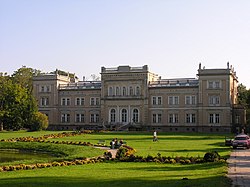Plungė
Plungė | |
|---|---|
City | |
 Plungė Manor | |
| Country | |
| Ethnographic region | Samogitia |
| County | Telšiai County |
| Municipality | Plungė district municipality |
| Eldership | Plungė town eldership |
| Capital of | Plungė district municipality Plungė town eldership Plungė rural eldership |
| First mentioned | 1567 |
| Granted city rights | 1792 |
| Population (2015) | |
| • Total | 18,904 (16th) |
| Time zone | UTC+2 (EET) |
| • Summer (DST) | UTC+3 (EEST) |
| Website | http://www.plunge.lt |
Plungė (, Samogitian: Plongė, Yiddish: פּלונגיאַן) is a city in Lithuania with 23,246 inhabitants. It has a crab stick factory which exports to many countries in Europe.
Before World War II, Plungė had a large Jewish population (see The Holocaust in Lithuania).
History



It is thought that the territory in which Plungė is situated was inhabited in 5th–1st centuries BC. After the Treaty of Melno country seats were started establishing in the forests of Samogitia. From the 14th century to the middle of the 16th century, Plungė was a part of Gandinga volost as an ordinary settlement. Later, the population of Plungė started to grow faster and surpassed the population of Gandinga. In 1567 Plungė was mentioned as a town.
On January 13, 1792, Plungė granted Magdeburg rights. From 1806 to 1873 Plungė belonged to Platon Zubov, and later – to Oginskiai, who built a palace here in 1879.
During the interwar period there was established gymnasium in 1925 and built railway branch-line in 1932. In 1933 current Catholic Church was consecrated. Since the private hospital was founded in 1939, maternity, surgical sections started their activities. Jewish community composed about 44% of inhabitants whereas about 55% of inhabitants were Lithuanians. According to that Jewish were active participants governing the city. However, in events of 1941 almost all Jewish community was destroyed by the Nazis and their local Lithuanian collaborators in mass executions.[1][2][3]
During the years of the independence of Lithuania Plungė's economic was based on the factory of fibre flax and cotton Kučiskis – Pabedinskiai and also on the activities of Jewish businessmen and agricultural products made by Samogitian farmers.
After World War II and the Soviet occupation, Plungė started to grow rapidly – if the city had 7,400 inhabitants in 1950, in 1990 it had already had 23,300 inhabitants. During the years of Soviet occupation, Lithuanians became the majority of city's inhabitants. According to Government's Resolution of 1963, Plungė should have become regional centre with a strong industry. However these plans were ruined when it became obvious that the city doesn't have enough water resources although some high level companies representing various branches of industry were established in Plungė. Most of these companies however bankrupted after the Independence of Lithuania was announced.[4]
The coat of arms of Plungė was affirmed by the decree of the President on June 6, 1997.[5] In 2009 Plungė was elected Lithuanian Capital of Culture.[6] Nowadays Plungė is the sixteenth largest city of Lithuania having 22,287 inhabitants.
Origin of the Name
Origin of the name Plungė is not clear enough. The most persuasive theory is that the name of the city is issued from the name of river Paplunga which flowed through the city.[7] The city's name is Płungiany in Polish, Plongė in Samogitian, Plungyan in Yiddish and lastly Плунгяны in Russian[8]
Main sights
- Plungė Manor
- Plungė District Municipal Public Library
- Plungė park
- St. John the Baptist Church
- St. Florian's sculpture
Transport


Important highways are built near the city:
Plungė also has railway station. Trains going by the route Vilnius–Klaipėda and Radviliškis–Klaipėda stop there.
Sports
Football club "FK Babrungas Plungė" plays in Lithuanian Football Federation's 2 League's Western Zone. Team plays in the Central Stadium of Plungė.
Basketball club "Olimpas Plungė" plays in National Basketball League. The team was established in 1989. In 1997, BC Olimpas played in the Lithuanian Basketball League finals, where they lost to BC Žalgiris Kaunas. Afterwards, the team didn't appear in national competitions until 2011. Olimpas Plungė started to play in Regional Basketball League and won gold medals in 2012 and qualified to National Basketball League. In 2012-2013 National Basketball League's regular season team finished 3rd amongst 18 teams, however it lost the Quarter-finals series 2-0 to BC Žalgiris Kaunas 2.[9] Team plays in "SS Žemaitijos Suvenyras" arena, which has a capacity of 200 people.
International relations
Twin towns – Sister cities
Plungė is twinned with:
|
|
Famous Residents
- Famous Lithuanian composer and artist M. K. Čiurlionis (1875–1911) had lived here at the end of the 19th century
- Singer Aistė Smilgevičiūtė (Plungė, 1977) was born here
- Bronislovas Lubys (1938–2011), entrepreneur, former Prime Minister of Lithuania, signatory of the Act of the Re-Establishment of the State of Lithuania, and businessman.
- Miss Lithuania 2007 Jurgita Jurkutė (Plungė, 1985) was born here
- Lazarus Goldschmidt (Plungė, 1871–1950), translator of the Talmud.
- Historian Zenonas Ivinskis (Plungė, 1908–1971) was born here
- Wanda Rutkiewicz (1943–1992), one of the most famous climbers in the history of mountaineering, the first European to reach the summit of Mount Everest and the first female climber to reach K2.
- Chaim Yitzchak Hacohen Bloch was born here and later served as Rosh Yeshivah.[10]
References
- ^ http://www.holocaustatlas.lt/EN/#a_atlas/search//page/1/item/186/
- ^ http://www.holocaustatlas.lt/EN/#a_atlas/search//page/1/item/233/
- ^ http://www.holocaustatlas.lt/EN/#a_atlas/search//page/1/item/232/
- ^ http://plunge.lt/index.php?-2010671678
- ^ http://www3.lrs.lt/pls/inter3/dokpaieska.showdoc_l?p_id=39832
- ^ http://www.15min.lt/naujiena/aktualu/lietuva/lietuvos-kulturos-sostine-2009-metais-bus-plunge-video-56-20294
- ^ http://www.pzinios.lt/Rubrikos/Aktualijos/Is-ko-kiles-gimtojo-miesto-vardas
- ^ http://www.degruyter.com/dg/viewarticle.fullcontentlink:pdfeventlink/$002fj$002fwerk.2014.9.issue-2$002fwerk-2014-0008$002fwerk-2014-0008.pdf?t:ac=j$002fwerk.2014.9.issue-2$002fwerk-2014-0008$002fwerk-2014-0008.xml
- ^ http://www.nklyga.lt/lt/news/-zalgirio-dubleriai-perzenge-olimpo-barjera/
- ^ Toldot Anshei Shem. p. 9.
External links
- The murder of the Jews of Plungė during World War II, at Yad Vashem website.



